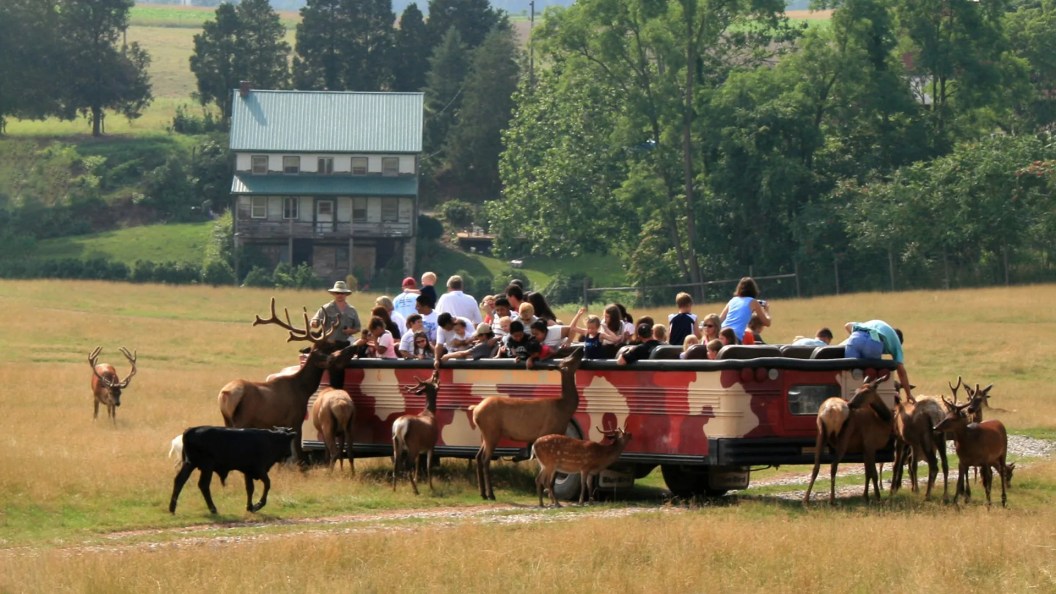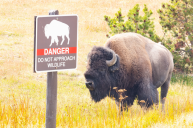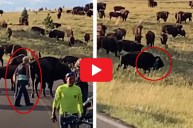We've all had the urge to pet a wild animal, and bison can look particularly inviting with their fluffy fur and wide eyes. Unfortunately, this doesn't always work out in our favor—even for trained professionals.
On Saturday, June 17, 19-year-old Riley Blanchard was operating as a safari tour bus driver at Lake Tobias Wildlife Park in Halifax, Pennsylvania when she reached out to pet the animal. She has held this job for two years, and told PennLive she has pet him several times before.
This particular time, the bison was not into it.
Blanchard was standing on the steps of the tour vehicle, blocked off by chains, when she reached out to pet the bison. He gored her in the thigh, causing her to fall out of the bus.
The bison reportedly walked away after catching her leg-a pretty harsh way to say, "No thank you."
Blanchard said most of the guests didn't notice the fiasco, but the two that did were eager to assist her with the first aid kit. She reached out to the park's first aid station for help, and was transported to a more accessible location for ambulance pick up. She shared she was hospitalized and released the same day, receiving a few stitches on the back of her left thigh.
The Outcomes
With her injury, Blanchard was advised to stay out of work for two weeks. She shared her understanding is that the park plans to add doors to the safari vehicles rather than chains for some added protection against future potential incidents.
Blanchard appeared to be in relatively good spirits after such a challenging event and appears to hold no anger towards the bison. She stated "I love animals and I think I just got a little too comfortable with the bison, it's a wild animal." With relatively minor injuries, Blanchard said she was told her height-6 feet, 4 inches-is what saved her from a potentially catastrophic injury, and that she is glad it happened to her rather than another employee.
As for the bison-well, hopefully he got some alone time to decompress, since it clearly wasn't his best day either.
How to Avoid This
Having a relatively curated experience with a tour guide inside a park, not out in the wilderness makes it easy to feel safe and forget the wild part of the term 'wild animal'. But it's important to remember you're in a wildlife park with wild animals; even though Lake Tobias Wildlife Park allows physical interactions with the animals, it doesn't mean all bison will tolerate this, nor that the bison in the park will always allow it.
Animals don't speak the same language as we do, so often their behavior is the only way they can communicate. This bison gave a pretty clear message of wanting some personal space, and luckily for Blanchard, the situation was managed well and the injury was "minor" compared to what it could have been; receiving a few stitches is a way better outcome than the damage a creature like a bison could do.
A 2019 report from Utah State University identified bison as the culprit for more wildlife-related injuries in Yellowstone National Park than any other animal. In an area that contains plenty of other wild animals-grizzly bears, wolves, coyotes, cougars, elk, and moose, just to name a few-it's easy to overlook seemingly docile bison, but important to remember that they can be dangerous too. Bison are herbivores, so they don't attack humans in a predatory fashion, but they will attack if they are feeling threatened or bothered, and they are particularly aggressive during mating season and around their young.
Animal behavior isn't always predictable, and when in doubt, edge on the side of caution. When interacting with a wild animal, anything can happen, and getting gored by a bison isn't a great way to spend what could otherwise be a great trip to observe wildlife.
READ MORE: The Number One Thing to Know Before You Visit Yellowstone




